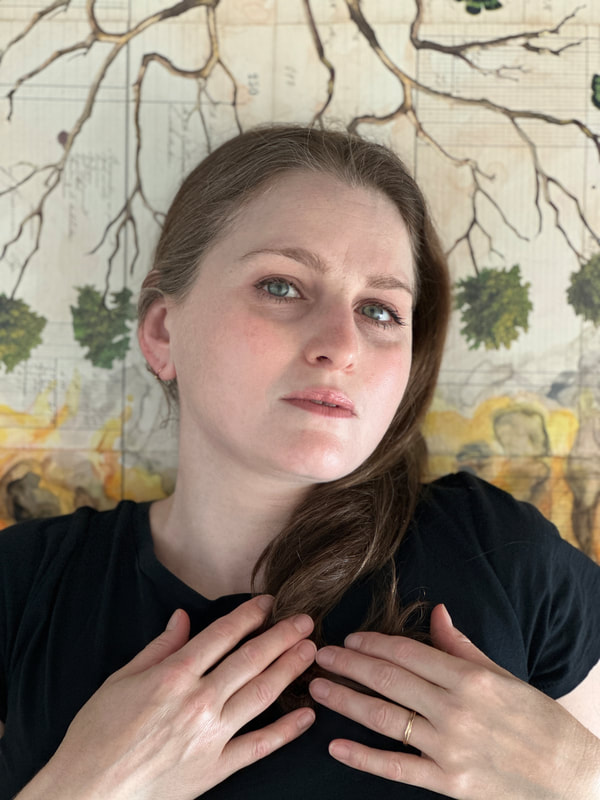Upcoming
The Mysteries
Opening Reception September 14th, 2024 4pm-6pm
Show runs from -
September 14th, 2024 - November 9th, 2024
(These six images represent a small percentage of the entire exhibit - see the full exhibit in person or contact us for addition images and info on the entire exhibit.)
Artist - Alexandra N Sherman
Statement
In 2020 I embarked upon the most technically difficult and emotionally intense work of my life in a series of assemblages, that have taken me three years to complete, called “The Mysteries”. Each piece is created with a variety of techniques and papers, many of
which are antique or vintage, layered atop antique invoices and ledgers. Each piece was then married to a vintage or antique frame, some as is, and others I altered. All surfaces of the objects are treated, including the backs. I see each “Mystery” as a portal, a liminal space where two realities exist simultaneously, an internal and an external. Natural elements, lover’s eyes, mouths, and hands play an important role in the iconography of this work exploring life, death, and intimacy. I use the positions of the hands to express emotion and begin to tell a story, the thread of which, I hope the viewer will pick-up and embellish. I employ lover’s eyes that gaze back at the viewer, creating the sense of an exchange and intimacy further enhanced by the book-like scale of the work. The skies glimpsed through the doors, flora and fauna conveying transience, impermanence, and the sublime. I find the mark-making, printing and varieties and variance of antique and vintage paper intriguing. Responding to the existing handwritten marks feels like a collaboration with people in the past. I seek to transform that which was considered mundane into the extraordinary. I see the time periods represented by these documents as a mirror to the world we live in now, with war, discord, and pandemics, and yet they survived...
Each of “The Mysteries” has a petite “Mystery” on the back influenced by craft traditions that treat unseen surfaces of the work. Conceptually, it is the idea of seeing an image, committing it to memory, but not being able reinforce the impression by repeated viewings. The viewer carries an image in their mind, which then shifts and morphs over time until they interact with it again, comparing and contrasting what they remember and what they see now. The antique frames are the antithesis of ready-made, mass produced objects. I chose each frame to complement my work and in some cases, I created work responding to the frame. As the artist, I am responsible for every single aspect of the piece, much in the manner of many late 19th century artists, to remove the frame would be to destroy the piece.
which are antique or vintage, layered atop antique invoices and ledgers. Each piece was then married to a vintage or antique frame, some as is, and others I altered. All surfaces of the objects are treated, including the backs. I see each “Mystery” as a portal, a liminal space where two realities exist simultaneously, an internal and an external. Natural elements, lover’s eyes, mouths, and hands play an important role in the iconography of this work exploring life, death, and intimacy. I use the positions of the hands to express emotion and begin to tell a story, the thread of which, I hope the viewer will pick-up and embellish. I employ lover’s eyes that gaze back at the viewer, creating the sense of an exchange and intimacy further enhanced by the book-like scale of the work. The skies glimpsed through the doors, flora and fauna conveying transience, impermanence, and the sublime. I find the mark-making, printing and varieties and variance of antique and vintage paper intriguing. Responding to the existing handwritten marks feels like a collaboration with people in the past. I seek to transform that which was considered mundane into the extraordinary. I see the time periods represented by these documents as a mirror to the world we live in now, with war, discord, and pandemics, and yet they survived...
Each of “The Mysteries” has a petite “Mystery” on the back influenced by craft traditions that treat unseen surfaces of the work. Conceptually, it is the idea of seeing an image, committing it to memory, but not being able reinforce the impression by repeated viewings. The viewer carries an image in their mind, which then shifts and morphs over time until they interact with it again, comparing and contrasting what they remember and what they see now. The antique frames are the antithesis of ready-made, mass produced objects. I chose each frame to complement my work and in some cases, I created work responding to the frame. As the artist, I am responsible for every single aspect of the piece, much in the manner of many late 19th century artists, to remove the frame would be to destroy the piece.
Biography
|
Alexandra N Sherman ’s art explores the landscape of the mind through watercolors painted from her subconscious, installations with found or created objects, and collage using vintage and antique ephemera. She seeks to give the viewer an intimate experience through works that explore the uncertainty and mystery inherent in life, ourselves, the environment and the need for conservation. Her work depicts the spaces in between, the seen and unseen through ambiguous narrative that invites the viewer to complete the story.
Alexandra grew up and worked in the antiques business which inspired her love of art and the decorative arts. She has an MFA from the University of Wisconsin, Madison in painting and trained in ateliers L’Eclat De Verre and Gold Leaf Studios where she studied framing, and the art of cartonnage. Her curatorial experience includes assistant curator for Mobil modern art collection, and the curator of The Dadian Gallery. Her work has been shown nationally and internationally. |
Website - ansherman.com/
Instagram - www.instagram.com/alexandransherman/
Facebook - www.facebook.com/Anshermanart
Instagram - www.instagram.com/alexandransherman/
Facebook - www.facebook.com/Anshermanart

